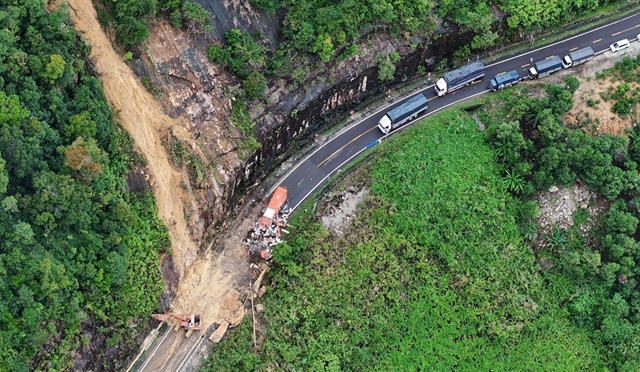 Environment
Environment

HÀ NỘI — All three existing species—the Asian elephant, the African savanna elephant and the African forest elephant—are at risk of extinction, with an estimated 50,000 Asian elephants and 415,000 African elephants remaining in the wild.
These numbers reflect a dramatic population decline: Asian elephant numbers have fallen by at least 50 per cent since 1945, African forest elephants by at least 90%, and African savanna elephants by 70 per cent in just 52 years, from 1964 to 2016.
This urgent reality underscores the importance of coordinated, science-led action—such as safeguarding habitats in Asia and Vietnam, advancing humane fertility control, and ending the trade in elephant trophies—to ensure a future where elephants and people can coexist.
Protecting Asia’s elephants in a changing landscape
Across Asia, Humane World for Animals (formerly Humane Society International) is working on the front lines in India and Việt Nam to secure a future for elephants. In Karnataka, India—home to the world’s largest Asian elephant population—the organisation is building a safe, inclusive model of coexistence, protecting communities while giving elephants the space they need to roam.
 |
| Wild Asian elephants in Việt Nam. Images captured by camera traps as part of HSI Viet Nam's project to monitor the wild population and humanely mitigate human-elephant conflict. |
In Việt Nam, a groundbreaking initiative in Đồng Nai is setting new standards for elephant conservation. Partnering with the national government and local communities, Humane World for Animals has, for the first time, compiled detailed, evidence-based profiles of individual elephants, their herd structure, and breeding patterns—identifying more than 25 elephants, including newborn calves, by 2025. This breakthrough has been made possible through the creative use of camera traps and community-led monitoring. The results, together with humane, collaborative approaches, have shaped Việt Nam’s Elephant Conservation Action Plan to 2035, officially adopted in August 2024.
To ensure the benefits extend nationwide, the organisation has produced comprehensive field guides and delivered practical training to strengthen ranger patrols and protection measures across the country. In September, Humane World for Animals joined forces with the Vietnamese government and the IUCN Asian Elephant Specialist Group (AsESG) to co-host the 12th AsESG meeting and celebrate Elephant Week in Đồng Nai—spotlighting innovative strategies in research, training, and community engagement, all aimed at nurturing peaceful coexistence between people and elephants.
Birth control that’s changing the future for elephants
While elephant populations continue to decline overall, habitat loss and land-use policies are often forcing herds into confined areas, hemmed in by physical barriers such as fences or restricted zones. This shrinking range fuels competition for resources and intensifies conflict between elephants and people.
 |
| Humane World for Animals South Africa Wildlife Senior Director Dr Audrey Delsink and Project Implementation Specialist JJ van Altena with Helicopter Pilot during aerial immunocontraception vaccinations. Photo Humane World for Animals |
Immunocontraception—a birth control method developed for wildlife—offers a proven, humane alternative to the culling of elephants, a practice that many scientists, including Dr Audrey Delsink, view as a misguided attempt to manage wild populations. For years, Delsink and her colleagues at Humane World for Animals have led pioneering campaigns using porcine zona pellucida immunocontraception, a non-surgical technique that uses a pig-derived egg protein to prevent pregnancy in elephants. This approach, combined with coexistence strategies, is making a tangible difference for this iconic species.
Thanks to the leadership of Humane World for Animals—together with partners at the Onderstepoort Veterinary Wildlife Population Control Laboratory, skilled wildlife practitioners and collaborating reserves—more than 1,700 wild female elephants across 50 reserves in South Africa have been safely vaccinated, helping to ease population pressure and prevent future conflict.
To date, 70 per cent of female elephants outside the Greater Kruger National Park—where the method is not yet applied—have received treatment. Given that a single female elephant can produce eight to ten calves in her lifetime, the programme’s exponential impact is clear.
Beyond population control, the organisation is expanding safe spaces for elephants and communities by promoting and completing elephant-proof fencing at Ithala Game Reserve in KwaZulu-Natal province. In the same province, it supports three community elephant monitors working in locally managed reserves that are home to wild elephants.
Confronting the trophy trade threat
Although the international ivory trade is banned under CITES—the Convention on International Trade in Endangered Species of Wild Fauna and Flora—illegal trafficking continues to drive the killing and decline of elephant populations. Alongside the devastation of poaching, trophy hunting also takes a heavy toll. Hunters can still obtain permits to kill elephants and take their body parts home as gruesome souvenirs, exploiting a loophole in ivory transport bans.
 |
| African elephant - Mabula Private Reserve, S. Africa. Photo Humane World for Animals |
South Africa remains the leading exporter of CITES-listed mammal trophies in Africa—including elephants—and one of the largest exporters worldwide, with more than 23,000 animals exported as trophies between 2019 and 2023.
Humane World for Animals is spearheading the #NotInMyWorld campaign, urging the European Union and its member states to close the door on trophy imports. The organisation and its partners warn that trophy hunting in East Africa’s Greater Amboseli–Kilimanjaro West ecosystem is endangering the continent’s fewer than 50 remaining “super tuskers”—mature males with tusks over 45kg vital to ecological balance and male elephant social structures.
A short film by Humane World for Animals South Africa, Tuskers: Saving the Last Gentle Giants, recently reached the semi-finals of the international Pet Carpet Film Festival in Italy. Directed by award-winning filmmaker Nick Chevallier, it tells the story of these rare giants and why their survival matters—not just to the species, but to entire ecosystems. VNS